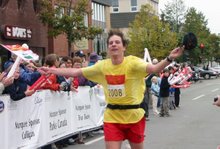 Stan Chaisson
Stan ChaissonStarting to run can be very exciting and motivating, but it’s important to be patient and
ease into your training. Walking and running have many great benefits so it’s easy to get
overzealous and do too much too soon. Many times beginners run too fast. They believe
they can run a marathon the first day they step outside to train. This usually results in
shortness of breath, screaming muscles, and an instant turn off to running. They soon
become discouraged and don’t train as much or quit all together.
Instead, you need to begin at a pace that is comfortable and for most people I would
suggest walking first. Continuous walking will slowly prepare your legs for running and
will also help you develop a consistent daily routine. If you have been previously inactive, don't rush the process. The first step for an exercise program (after you get a
medical exam) is to ask yourself, what plan will work for my lifestyle? Take the time to
set short and long term realistic goals. As your fitness improves, gradually introduce
running into your program until you are comfortable and confident to complete your
chosen event in October. Typical training goals for a walk/run program would be four
times per wee
 k, 20 to 30 minutes of exercise per session.
k, 20 to 30 minutes of exercise per session.Being conservative with how often you walk or run is crucial especially if you are just
beginning or are coming off a long break. It's very common for new runners to
experience aches and pains, especially if you're training for a long-distance event. Many
times this is muscle soreness and nothing a day off can’t repair. But when you feel pain in
one particular spot, it could be a sign that something's wrong. Pay attention to aches and
pains and if a pain gets worse as you’re running, that's a warning sign that you should
stop your run. Listen to your body for warning signs and know your limits.
To avoid injury you should recover properly. Take at least two days off from walking and
running each and every week. Don't ignore rest days as they are important to your
recovery and injury prevention efforts. Your muscles build and repair themselves during
your rest days. So if you run every day, you're not going to get the most out of your
efforts, and you're increasing the risk of injury.
Stretching is another key to success. Stretching can reduce the risk of injuries, improve
joint mobility, help increase your stride length and reduce muscle soreness. Stretching in
your daily life is also a great way to reduce stress and tension. I often prescribe stretch
and strengthen days for my training groups to ensure they take the time off from the
pavement that they need.
Whatever your reasons for starting to run - whether you want to get fit, lose weight, or
lead a more energetic life, you need to be realistic and careful not to be too ambitious.
Remember all good things come in time.
Stan Chaisson is a registered kinesiologist, trainer, avid runner, and exercise enthusiast. His weekly column will provide advice and training tips for those preparing for the BMO Prince Edward Island Marathon, October 18-19 (www.princeedwardislandmarathon.com)





















No comments:
Post a Comment